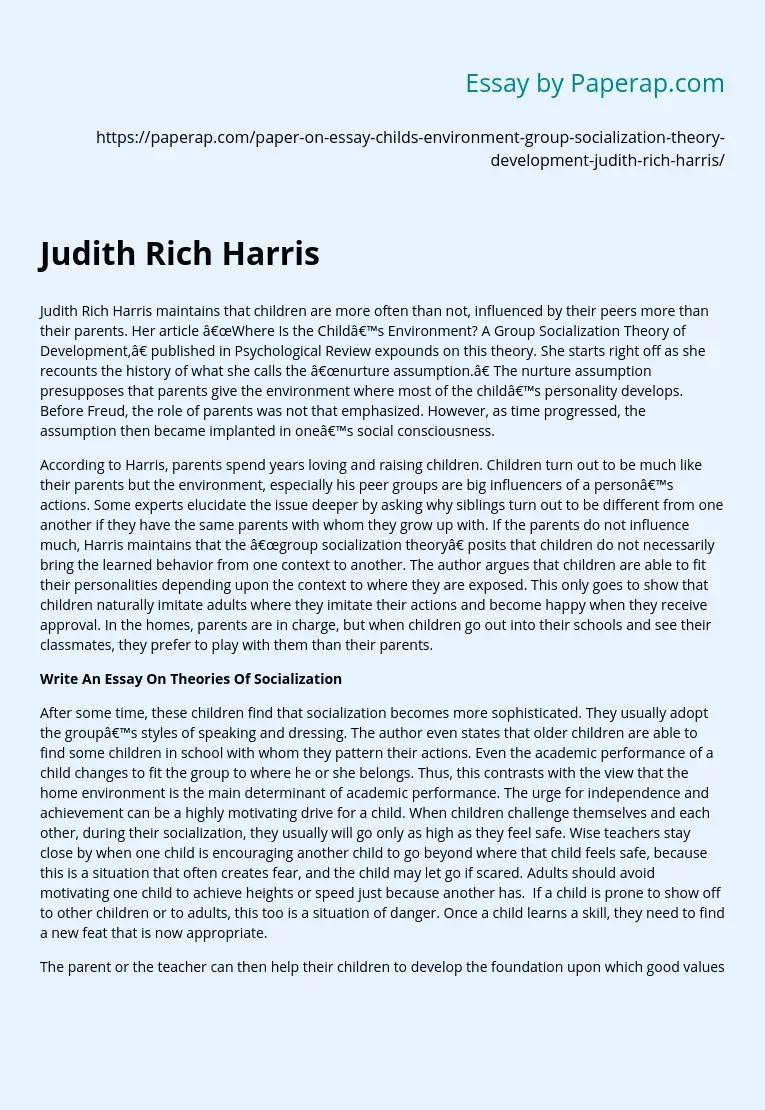Judith Rich Harris
Judith Rich Harris maintains that children are more often than not, influenced by their peers more than their parents.
Her article “Where Is the Child’s Environment? A Group Socialization Theory of Development,” published in Psychological Review expounds on this theory. She starts right off as she recounts the history of what she calls the “nurture assumption.” The nurture assumption presupposes that parents give the environment where most of the child’s personality develops. Before Freud, the role of parents was not that emphasized.
However, as time progressed, the assumption then became implanted in one’s social consciousness.
According to Harris, parents spend years loving and raising children. Children turn out to be much like their parents but the environment, especially his peer groups are big influencers of a person’s actions. Some experts elucidate the issue deeper by asking why siblings turn out to be different from one another if they have the same parents with whom they grow up with.
If the parents do not influence much, Harris maintains that the “group socialization theory” posits that children do not necessarily bring the learned behavior from one context to another. The author argues that children are able to fit their personalities depending upon the context to where they are exposed. This only goes to show that children naturally imitate adults where they imitate their actions and become happy when they receive approval. In the homes, parents are in charge, but when children go out into their schools and see their classmates, they prefer to play with them than their parents.
Write An Essay On Theories Of Socialization
After some time, these children find that socialization becomes more sophisticated. They usually adopt the group’s styles of speaking and dressing. The author even states that older children are able to find some children in school with whom they pattern their actions. Even the academic performance of a child changes to fit the group to where he or she belongs. Thus, this contrasts with the view that the home environment is the main determinant of academic performance. The urge for independence and achievement can be a highly motivating drive for a child. When children challenge themselves and each other, during their socialization, they usually will go only as high as they feel safe. Wise teachers stay close by when one child is encouraging another child to go beyond where that child feels safe, because this is a situation that often creates fear, and the child may let go if scared. Adults should avoid motivating one child to achieve heights or speed just because another has. If a child is prone to show off to other children or to adults, this too is a situation of danger. Once a child learns a skill, they need to find a new feat that is now appropriate.
The parent or the teacher can then help their children to develop the foundation upon which good values are built. The guidance of the teacher should be very personal—given directly to the child in quiet, reassuring tones. Shouts across the play yard are usually totally ineffective. Children do not know that one means the shouts for them, and they may actually not hear what is said.
Harris’ belief that peer influences are now more than what parents show can have several implications. The author maintains that the children are able to blend in a group and learn many things from individuals in that context. Children play a role in their own socialization. As most parents will say, children are sometimes the ones responsible for how they are treated by others. One knows that if he smiles, he is more likely to get a smile back. The way one socializes with children often is influenced by their reaction to the other person. They respond differently physiologically to various experiences. This is evident because children have individual differences in activity level, adapting to new situations. How other children respond to another child’s temperaments influences the socialization process. If there is a “goodness of fit” between a child’s temperament and his or her caregivers, then socialization is likely to proceed smoothly. An example is if the child does not get used to new things slowly, then socialization is likely to be smooth.
If, on the other hand, the fit between the child’s temperament and the caregivers’ is poor, socialization is likely to be rough. For example if the child is very active, responds intensely to people and things, and is moody, and the caregivers force him or her to sit still, punish him or her for crying or being frightened, and demand a smile most of the time, then socialization may turn out to be a battleground of wills.
As infants become children, adolescents and then adults, they interact with more people and have more experiences. In so doing, they acquire skills, knowledge, attitudes, values, motives, habits, beliefs, interests, morals and ideals. One may learn to read from the first-grade teacher.
Thus, from the point of view of society, individuals are socialized to fit into an organized way of life. And from a personal point of view, socialization has enabled them to discover their selves—their potentialities for personal growth and fulfillment. By going to school, children not only gain knowledge; they also find out in what subjects they do best. As members of a peer group, they not only learn to cooperate; they find out whether they are leaders or followers.
Judith Rich Harris. (2019, Dec 05). Retrieved from https://paperap.com/paper-on-essay-childs-environment-group-socialization-theory-development-judith-rich-harris/

